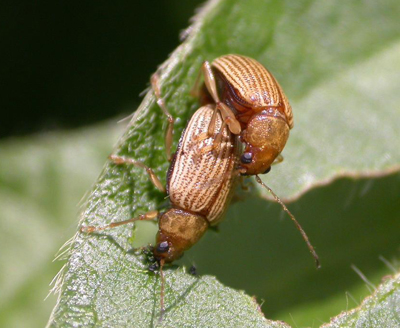
- Grape Colaspis (Colaspis brunnea) rarely causes economic damage in corn or soybeans, except in certain years like this one.
- Larvae feed on crop roots and adults feed on foliage.
- Numbers of grape colaspis and damage may relate to weather the previous season.
- There are no rescue treatments or consistent preventative treatments for grape colaspis.
Description and Life Cycle:
The grape colaspis is in the beetle family. Larvae look very much like tiny white grubs, about 1/8 to 1/5 inch long and slightly curved. They lack the swollen tip of the abdomen featured by other grubs. With magnification, tiny, bumps can be seen on the underside of the abdomen and bunches of short bristles or hairs protrude from these bumps. Larvae have distinct, light brown head capsules and three pairs of short legs.
Adults, or beetles, are small, only about 1/6 inch long, oval-shaped and light brown in color. The wing covers (elytra) feature parallel rows of puncture marks between longitudinal ridges.
The grape colaspis has one generation per year in our area. Adults lay eggs between July and early September. Eggs hatch, and larvae feed for a short time on host plant roots before going deeper in the soil to overwinter. In the spring, as soils warm, colaspis larvae move back up in the soil and again begin feeding on fine roots and root hairs. Crop damage usually peaks in late May and early June. By mid-June larvae start to pupate. Adults usually begin emerging in late June and much of July. They then mate and begin to lay eggs.
Hosts, Damage and Scouting:
Grape colaspis has been found to survive on numerous field crops, legumes, and vegetable crops. At one time, grape colaspis was strongly associated with legumes, like red clover, and damage often occurred to whatever crop followed the clover in rotation. As red clover became less popular in crop rotations, grape colaspis damage seemed to often affect whatever crop was planted following a soybean crop. This insect now appears to have fully adapted to corn-soybean rotations and damage may occur to either corn or soybeans, plus many other crops. Legumes are still a preferred crop for grape colaspis feeding.

Grape colaspis damages crops in both the larval and adult stages, with larval damage being, by far, the most severe. The tiny grubs graze on root hairs and gouge the main roots of host crops. This results in failure of the crop to take up adequate water and nutrients. As a result, affected plants are often stunted, appear drought stressed, and often have desiccation injury to leaves. Young corn frequently develops a purple color as a result of inability of damaged roots to take up enough phosphorous. Crops damaged by grape colaspis often recover somewhat unless multiple stressors are at work.
When grape colaspis damage is suspected, dig up affected plants and search through the soil for the tiny grubs. There is no established damage threshold (number of grubs to cause economic damage) but it usually takes several grape colaspis larvae to cause notable injury to plants. If the larvae are nearing the end of their life cycle, pale-colored pupae may be found along with the larvae. By the middle of June, larvae may be disappearing from the soil as they finish their development. Carefully wash roots and look for slender gouges in the roots or tiny scars where hair roots have been pruned off. This type of damage can be very difficult to diagnose. Damage from grape colaspis can also be additive with environmental, pest and disease injury, increasing uncertainty about How much damage the colaspis larvae are really doing.
Beetle feeding from grape colaspis is distinctive, although it can easily be confused with damage from other pests. The beetles chew small, squared holes that link together, giving the damage a “jigsaw” appearance. This type of damage is rarely economic, but standard defoliation thresholds can be used when scouting.
Prediction and Management
Grape colaspis activity and damage is difficult to predict. One important factor appears to be soil moisture from July through September. If soil moisture during this time is average to above average, grape colaspis survival is usually good. Hot, dry soils seem to cause heavy mortality. Grape colaspis distribution in the field is usually clumped or variable.
There are no insecticide rescues treatments for grape colaspis. Banded soil insecticide treatments provide very inconsistent control of this insect. Systemic insecticide seed treatments sometimes suppress grape colaspis root feeding, but not always. Because of the inherent unreliability of insecticide treatments and because of the variability of this pest, planned treatments are not advised.

Image 1: Grape Colaspis Male & Female Beetles
Image 2: Grape Colaspis Larva Showing Abdominal “Pegs” and Bristles
Image 3: Grape Colaspis Size Variation